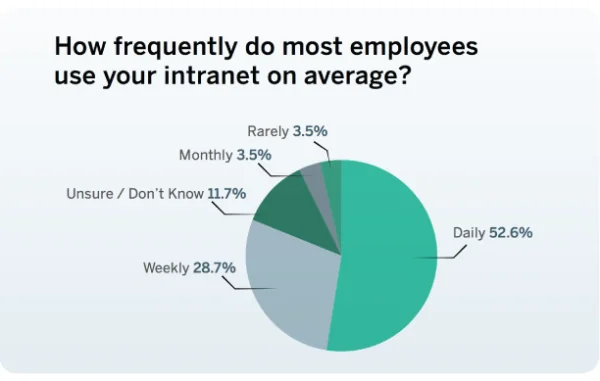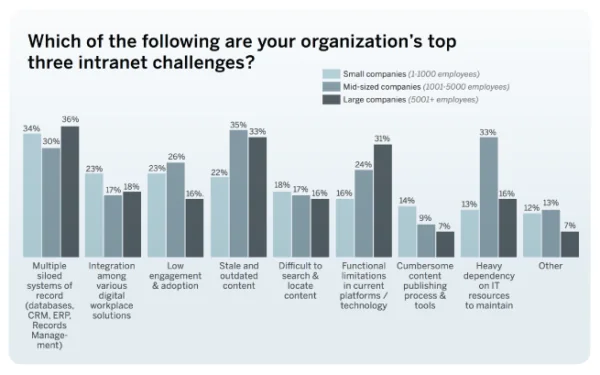Simpplr recently teamed up with CMSWire to conduct a survey of hundreds of IT, HR, and employee communications professionals from organizations of all sizes. The objective of the survey was to get a current snapshot of how companies view, engage with, and get value out of their corporate intranets. We wanted to know: Are intranets proving their worth or are they declining as a corporate “must have” technology?
We posed several questions to capture trends affecting the intranet. Here are a few highlights from the survey findings.

Importance of an intranet
In our survey, the importance of an intranet ranks highly, with 79% of respondents considering the intranet to be important. Intranets continue to be considered as important business tools and if we consider them as a solution within the broader digital workplace architecture, these results also compare well with CMSWire’s 2017 State of the Digital Workplace Report, where over 48% of respondents rank the digital workplace as very or extremely important.

Intranet adoption and usage
Intranet adoption is critical but difficult to assess. Companies often set their intranet home page as the default web browser start page, but is just starting the browser with the intranet considered valuable usage?
Our respondents stated that their intranet achieved over 50% usage daily, with an additional 29% stating usage weekly. This gives 80% usage weekly or more. Based on past surveys, 50% daily usage is barely considered successful. 12% of respondents also said they didn’t know how frequently their intranet was being used – this raises questions about how those companies measure success.

Top intranet challenges
The top three challenges reported were:
- Multiple siloed systems of record (databases, CRM, ERP, Records Management)
- Stale and outdated content
- Heavy dependency on IT resources to maintain
It was also noted that large enterprises were more likely to report problems with integration among various digital workplace solutions, while mid-sized organizations were more constrained by functional limitations and difficulties with search.

Insights
Although the survey findings indicate that employee intranet software is considered important, current deployments are typically reflective of the lower end of maturity. Size is a factor. The average company is delivering content and training, but not necessarily using it as an engagement tool. While supporting business processes would be a more direct path to delivering business value, we also believe that failing to fully leverage intranets as a tool for employee engagement may be a missed opportunity in many cases.
Looking more closely at the results, we found that small and mid-sized organizations were generally more concerned about search, whereas larger enterprises were equally concerned about search and employee engagement. These were closely followed by the growing remote workforce and the complexity of the application environment. It was felt that working with multiple generations in the workforce was significant but that the move to contingent workforces is less significant.
Recommendations
Based on the results of this survey, we recommend pursuing practical intranet strategies that as much as possible allow businesses to focus on the things that matter and will help to improve their maturity.
This includes:
- Placing a greater emphasis on employee engagement – For small and mid-sized organizations not already thinking about this issue, it may require shifting from an emphasis on broadcast and static information sharing, to a more social or rich-content approach (such as video).
- Focusing content management efforts on searchability – As well as providing the right places to store content, it is just as important to make sure this information can be found by the right people, at the right time.
- Demand access to resources and tools to support better analytics and insight – Business stakeholders will never be convinced by basic intranet statistics, but you will need access to the right tools, data and possibly skills to paint a compelling picture – if you are replacing your intranet and can argue to spend money on an upgrade, make you sure include all the supporting capabilities.
- Targeting simple business process integration – Taking baby steps in the short-to-medium term and looking for quick wins or easy integrations that add value without much pain or complexity.
For more mature intranets already actively focused on the employee experience, we believe ownership of the intranet should be a consideration moving forward, if the goal is to provide a truly integrated employee experience.
The employee engagement environment is getting more complex, and it is unclear if many intranet solutions are ready for the changes that are happening now. Even where the good technical foundations are in place or are being upgraded, we remain concerned about the lack of maturity around sponsorship and vision, governance, and a lack of success measurements.
Has your organization adopted a corporate intranet? How does it add value to your organization? How are you measuring its success? What are your top intranet challenges? Tell us about the state of your organization’s intranet.
Get statistics regarding employee engagement within corporate intranets. Find out which intranet integrations are shaping the new digital workplace. Download the intranet & employee engagement survey results to learn more.

















